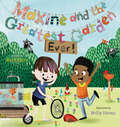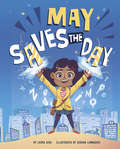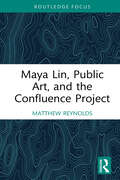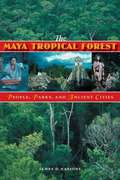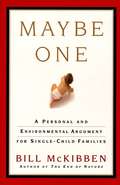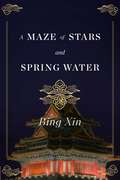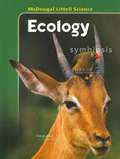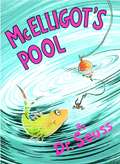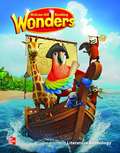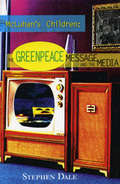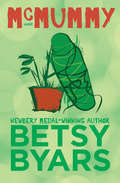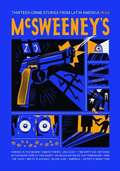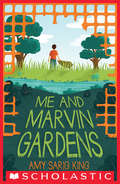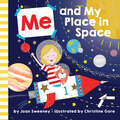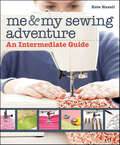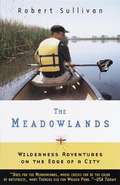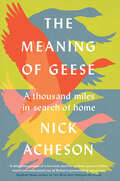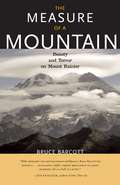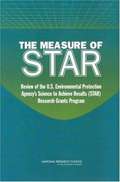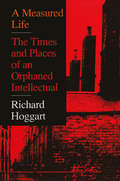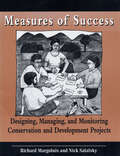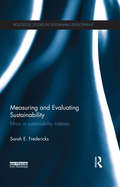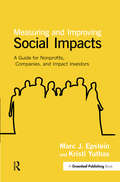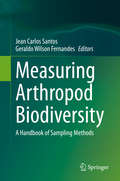- Table View
- List View
Maxine and the Greatest Garden Ever
by Ruth SpiroBest friends Maxine and Leo combine their maker and artistic skills to create (and save!) the ultimate garden in this empowering, STEM-focused picture bookAfter sketching and plotting and planting, Maxine and Leo know they've made The Greatest Garden Ever! But they're not the only ones who think so. Soon, all sorts of animals make their way in, munching on carrots and knocking over pots. When Leo and Maxine can't agree on a way to deter these unwelcome critters, it looks like there's more on the line than saving their garden--they just might need to save their friendship too.
May Saves the Day
by Laura GehlFrom her trendy suit to her messenger bag, May is the picture of a successful businesswoman. After all, she is founder and sole proprietor of Word Saver, Inc. Carrying her trusty bag of letters, May saves the day again and again, turning angry BEES into playful BEETS and a rampaging BEAR into a silly BEARD. Stu begs to be her sidekick, but May insists that a businesswoman does not need a sidekick. However, May quickly realizes that teamwork may be the word of the day when a tornado threatens the town. Author Laura Gehl brings word play to a new level in this adventurous and humorous picture book, featuring spirited art by Serena Lombardo.
Maya Lin, Public Art, and the Confluence Project (Routledge Focus on Art History and Visual Studies)
by Matthew ReynoldsThe first scholarly monograph devoted exclusively to this vital work of contemporary public art, this book examines Maya Lin’s Confluence Project through the lens of environmental humanities and Indigenous studies. Matthew Reynolds provides a detailed analysis of each earthwork, along with a discussion of the proposed final project at Celilo Falls near The Dalles, Oregon. The book assesses the artist’s longtime engagement with the region of the Pacific Northwest and explores the Confluence Project within Lin’s larger oeuvre. Several consistent themes and experiences are common amongst all the sites. These include an emphasis on individual, multisensory encounters with the earthworks and their surrounding contexts; sound as an experiential dimension of landscape; indexical accounts of the multicultural, multispecies histories of each place; and an evocation of loss. The book will be of interest to scholars working in art history, contemporary art, environmental studies, environmental humanities, and Native American studies.
The Maya Tropical Forest: People, Parks, and Ancient Cities
by James D. NationsThe Maya Tropical Forest, which occupies the lowlands of southern Mexico, Guatemala, and Belize, is the closest rainforest to the United States and one of the most popular tourist destinations in the Western Hemisphere. It has been home to the Maya peoples for nearly four millennia, starting around 1800 BC. Ancient cities in the rainforest such as Palenque, Yaxchilan, Tikal, and Caracol draw thousands of tourists and scholars seeking to learn more about the prehistoric Maya. Their contemporary descendants, the modern Maya, utilize the forest's natural resources in village life and international trade, while striving to protect their homeland from deforestation and environmental degradation. Writing for both visitors and conservationists, James Nations tells the fascinating story of how ancient and modern Maya peoples have used and guarded the rich natural resources of the Maya Tropical Forest. He opens with a natural history that profiles the forest's significant animals and plants. Nations then describes the Maya peoples, biological preserves, and major archaeological sites in Mexico, Guatemala, and Belize. Drawing on more than twenty-five years of conservation work in the Maya Tropical Forest, Nations tells first-hand stories of the creation of national parks and other protected areas to safeguard the region's natural resources and archaeological heritage. He concludes with an expert assessment of the forest's future in which he calls for expanded archaeological tourism to create an ecologically sustainable economic base for the region.
Maybe One
by Bill MckibbenFrom the groundbreaking, bestselling author of The End of Nature, a controversial and provocative book arguing that to help the planet we should begin to voluntarily limit our numbers. Bill McKibben's books and essays on our environment -- physical and spiritual -- have shaped and spurred debate since The End of Nature was published in 1989. Then, he sounded one of the earliest alarms about global warming; the decade of science since has proved his prescience. Now, in Maybe One, he takes on the most controversial of environmental problems -- population. We live in a unique and dangerous time, he asserts, when the planet's limits are being tested and voluntary reductions in American childbearing could make a crucial difference. The father of a single child himself, McKibben maintains that bringing one, and no more than one, child into this world will hurt neither your family nor our nation -- indeed, it can be an optimistic step toward the future. Maybe One is not just an environmental argument but a highly personal and philosophical one. McKibben cites new and extensive research about the developmental strengths of only children; he finds that single kids are not spoiled, weird, selfish, or asocial, but pretty much the same as everyone else. McKibben recognizes that the transition to a stable population size won't be easy or pain-free but ultimately is inevitable. Maybe One provides the basis for provocative, powerful thought and discussion that will influence our thinking for decades to come.
A Maze of Stars and Spring Water
by Bing XinA Maze of Stars & Spring Water is a collection of poems directly inspired by the poetic forms that emerged after the May Fourth Movement. Specifically, the “mini poem,” which by Bing Xin’s own admission, hadn’t quite existed before she started experimenting with its form. Inspired by Tagore’s Stray Birds, she started gathering her “scattered and fragmentary thoughts,” not originally intended as poetry, but which would eventually become the present collection. The popularity of the poems and the distinction of the form led the genre to become known as the “Bingxin style.”
McBroom the Rainmaker
by Sid FleischmanFarmer McBroom decides to put an end to the drought. Adventures Of McBroom.
McDougal Littell Science: Ecology
by James Trefil Rita Ann Calvo Kenneth CutlerScientists are curious. Since ancient times, they have been asking and answering questions about the world around them. Scientists are also very suspicious of the answers they get. They carefully collect evidence and test their answers many times before accepting an idea as correct. In this book you will see how scientific knowledge keeps growing and changing as scientists ask new questions and rethink what was known before.
McElligot's Pool
by Dr SeussA young man dreams of all the fish that might just be coming to be caught in McElligot's pool, from whales, to dogfish, from catfish to eels. Let your imagination run wild in this delightful story.
McGraw-Hill Reading Wonders [Grade 1, Volume 4]
by Diane August Donald R. Bear Janice A. DoleNIMAC-sourced textbook
McLuhan’s Children: The Greenpeace Message and the Media
by Stephen DaleMcLuhan’s Children is an inside look at Greenpeace’s rise to global prominence through its savvy use of mass media imagery. From the flamboyant, guerilla-theatre approach to the emergence of environmentalism as a dominant international issue.
McMummy
by Betsy ByarsThe giant pod in Professor Orloff&’s greenhouse is giving Mozie some terrifying nightmares . . .After Mozie loses his father, he longs for someone to look up to. Enter Professor Orloff: a brilliant, mysterious scientist with a greenhouse full of experimental vegetation. When he leaves on a trip, Orloff entrusts Mozie and Mozie&’s friend, Batty, with keeping an eye on his wondrous greenhouse. Inside, the two discover something amazing—and frightening: a plant pod big enough to fit a grown-up human. The pod seems to grow larger every day and to Mozie, it seems a little lonely. Soon, Mozie finds he&’ll do whatever it takes to protect the strange plant from harm and discover the secrets inside. This sometimes-spooky thriller will provide its readers with as many laughs as goosebumps. This ebook features an illustrated biography of Betsy Byars including rare images from the author&’s personal collection.
McSweeney's Issue 46
by Dave EggersIn thirteen electrifying stories, our very first all-Latin-American issue takes on the crime story as a starting point, and expands to explore contemporary life from every angle-swinging from secret Venezuelan prisons to Uruguayan resorts to blood-drenched bedrooms in Mexico and Peru, and even, briefly, to Epcot Center and the Havana home of a Cuban transsexual named Amy Winehouse. Featuring contemporary writers from ten different countries-including Alejandro Zambra, Juan Pablo Villalobos, Andres Ressia Colino, Mariana Enriquez, and many more-McSweeney's 46 offers an essential cross-section of the troubles and temptations confronting the region today. It's crucial reading for anyone interested in the shifting topography of Latin American literature and Latin American life, and a collection of writing to rival anything we've assembled in years.
Me and Marvin Gardens (Fountas & Pinnell LLI Blue)
by Amy Sarig King<p>Obe Devlin has problems. His family's farmland has been taken over by developers. His best friend Tommy abandoned him for the development kids. And he keeps getting nosebleeds, because of that thing he doesn't like to talk about. So Obe hangs out at the creek by his house, in the last wild patch left, picking up litter and looking for animal tracks. <p>One day, he sees a creature that looks kind of like a large dog, or maybe a small boar. And as he watches it, he realizes it eats plastic. Only plastic. Water bottles, shopping bags... No one has ever seen a creature like this before, because there's never been a creature like this before. The animal--Marvin Gardens--soon becomes Obe's best friend and biggest secret. But to keep him safe from the developers and Tommy and his friends, Obe must make a decision that might change everything. <p>In her most personal novel yet, Printz Honor Award winner Amy Sarig King tells the story of a friendship that could actually save the world.</p>
Me and My Place in Space (Me. . Books! Ser.)
by Joan SweeneyWhere am I in the solar system? A beloved bestseller, now refreshed with new art from Christine Gore, that will help children discover their place in the Milky Way. Where is the earth? Where is the sun? Where are the stars? Now with new art by Christine Gore, here is an out-of-this world introduction to the universe for children. With Earth as a starting point, a young astronaut leads readers on a tour past each planet and on to the stars, answering simple questions about our solar system. In clear language, drawings, and diagrams, space unfolds before a child's eyes. Colorful illustrations, filled with fun detail, give children a lot to look for on every page, and a glossary helps reinforce new words and concepts. A terrific teaching tool, Me and My Place in Space is an easy and enjoyable way to introduce the concept of space to budding astronomers.
Me & My Sewing Adventure: An Intermediate Guide
by Kate HaxellFollow-up to the best seller Me & My Sewing Machine! • Advance your skills in garment, home dec, and accessory sewing with this practical teaching guide • Simple (foolproof!) instructions and helpful photographs make it easy to learn challenging techniques • Bonus! 6 projects put the lessons to work After learning the basics in Me & My Sewing Machine, it’s now time to graduate to more sophisticated techniques in this follow-up book, Me & My Sewing Adventure. With her characteristic clarity and easy-to-follow instructions, author Kate Haxell guides you through the challenges and nuances of professional finishes, fabric manipulation, specialty seams, pattern construction, and much more. Once you master these skills, you’ll approach any sewing endeavor with a newfound confidence and ease. The book also includes an inspiring historical overview of vintage machines to complete your sewing education.
The Meadowlands: Wilderness Adventures at the Edge of a City
by Robert SullivanThe author, a journalist and urban explorer, describes the New Jersey Meadowlands, a sprawling marsh just west of Manhattan. Once logged for cedar, later the site of pig farms, the Meadowlands became a vast garbage dump. Unknown numbers of human bodies have disappeared into its mud, including, according to some, that of Teamsters' boss, Jimmy Hoffa. The author weaves stories of the area's colorful past with tales of his own explorations and encounters.
The Meaning of Geese: A Thousand Miles in Search of Home
by Nick Acheson‘A magisterial diary for bird lovers.’ Observer ⭐⭐⭐⭐ The Telegraph As seen on BBC Winterwatch 2023 ‘Honest, human and heart-grabbing. I loved this book so much.’ Sophie Pavelle, author of Forget Me Not ‘Delightful’ Stephen Moss, author of Ten Birds that Changed the World ‘Fascinating and thought-provoking’ Jake Fiennes, author of Land Healer ‘Awe-filled and absorbing’ Nicola Chester, author of On Gallows Down The Meaning of Geese is a book of thrilling encounters with wildlife, of tired legs, punctured tyres and inhospitable weather. Above all, it is the story of Nick Acheson’s love for the land in which he was born and raised, and for the wild geese that fill it with sound and spectacle every winter. Renowned naturalist and conservationist Nick Acheson spent countless hours observing and researching wild geese, transported through all weathers by his mother’s 40-year-old trusty red bicycle. He meticulously details the geese’s arrival, observing what they mean to his beloved Norfolk and the role they play in local people’s lives – and what role the birds could play in our changing world. During a time when many people faced the prospect of little work or human contact, Nick followed the pinkfeet and brent geese that filled the Norfolk skies and landscape as they flew in from Iceland and Siberia. In their flocks, Nick encountered rarer geese, including Russian white-fronts, barnacle geese and an extremely unusual grey-bellied brant, a bird he had dreamt of seeing since thumbing his mother’s copy of Peter Scott’s field guide as a child. To honour the geese’s great athletic migrations, Nick kept a diary of his sightings as well as the stories he discovered through the community of people, past and present, who loved them, too. Over seven months Nick cycles over 1,200 miles – the exact length of the pinkfeet’s migration to Iceland.
Measure of a Mountain: Beauty and Terror on Mount Rainier
by Bruce BarcottIn The Measure of a Mountain, Seattle writer Bruce Barcott sets out to know Rainier. His method is exploratory, meandering, personal. He begins by encircling it, first by car then on foot. He finds that the mountain is a complex of moss-bearded hemlocks and old-growth firs, high meadows that blossom according to a precise natural timeclock, sheets of crumbling pumice, fractured glaciers, and unsteady magma. Its snow fields bristle with bug life, and its marmots chew rocks to keep their teeth from overgrowing. Rainier rumbles with seismic twitches and jerks--some one-hundred-thirty earthquakes annually. The nightmare among geologists is the unstoppable wall of mud that will come rolling down its slopes when a hunk of mountain falls off, as it does every half century (and we're fifty years overdue). Rainier is both an obsession and a temple that attracts its own passionate acolytes: scientists, priests, rangers, and mountain guides. Rainier is also a monument to death: every year someone manages just to disappear on its flanks; imperiled climbers and their rescuers perish on glaciers; a planeload of Marines remains lodged in ice since they crashed into the mountain in 1946. Referred to by locals as simply "the mountain," it is the single largest feature of the Pacific Northwest landscape--provided it isn't hidden in clouds. Visible or not, though, it's presence is undeniable.
The Measure of STAR: Review of the U.S. Environmental Protection Agency's Science To Achieve Results (STAR) Research Grants Program
by Committee to Review EPA's Research Grants ProgramThe report favorably reviews the U. S. Environmental Protection Agency's competitive research grants program, finding that it has yielded significant new findings and knowledge critical for EPA's decision-making process. Established in 1995, the grants program was designed to enable the nation's best scientists and engineers to explore new ways to safeguard the environment and protect public health. The program awards about $100 million a year in grants and fellowships to independent investigators, multidisciplinary teams, and graduate students at universities and nonprofit institutions.
A Measured Life: The Times and Places of an Orphaned Intellectual
by Richard HoggartRichard Hoggart's book, The Uses of Literacy, established his reputation as a uniquely sensitive and observant chronicler of English working-class life. This pioneering work, first published in 1957, examines changes in the life and values of the English working class in response to mass media. It maps out a new methodology in cultural studies based around interdisciplinary and a concern with how textsin this case, mass publicationsare stitched into the patterns of lived experience. Mixing personal memoir with social history and cultural critique. The Uses of Literacy anticipates recent interest in modes of cultural analysts that refuse to hide the author behind the mask of objective social scientific technique. In its method and in its rich accumulation of the detail of working-class life, this volume remains useful and absorbing.
Measures of Success: Designing, Managing, and Monitoring Conservation and Development Projects
by Nick Salafsky Anna Balla Richard A. MargoluisMeasures of Success is a practical, hands-on guide to designing, managing, and measuring the impacts of community-oriented conservation and development projects. It presents a simple, clear, logical, and yet comprehensive approach to developing and implementing effective programs, and can help conservation and development practitioners use principles of adaptive management to test assumptions about their projects and learn from the results.The book presents a systematic approach to improving the focus, effectiveness, and efficiency of projects, with specific guidelines and advice on:designing a realistic conceptual framework based on local site conditions developing clearly defined goals, objectives, and activities creating a monitoring plan that can be used to assess whether goals and objectives are being met integrating social and biological science techniques to collect the most relevant and useful data in the most cost-effective way using the information obtained through the monitoring plan to modify the project and learn from the resultThe text is developed in eight chapters that follow the structure of a planning process from conception to completion, with the chapters linked by four scenarios that serve as teaching case studies throughout the book. Examples from these scenarios illustrate the processes and tools discussed, and each scenario case study is presented in its entirety in an appendix to the volume. The approach has been developed and field tested by practitioners working in many different projects in Latin America, Africa, and Asia, and their experience and input ensure that the guide is both practical and useful.Measures of Success is the only work of its kind currently available, and represents an invaluable resource for field-based practitioners, project managers, and local community leaders, as well as for international NGO staff, college and university teachers and students, researchers, and government officials.
Measuring and Evaluating Sustainability: Ethics in Sustainability Indexes (Routledge Studies in Sustainable Development)
by Sarah E. FredericksThe indexes used by local, national, and international governments to monitor progress toward sustainability do not adequately align with their ethical priorities and have a limited ability to monitor and promote sustainability. This book gives a theoretical and practical demonstration of how ethics and technical considerations can aid the development of sustainability indexes to overcome this division in the literature and aid sustainability initiatives. Measuring and Evaluating Sustainability develops and illustrates methods of linking technical and normative concerns during the development of sustainability indexes. Specifically, guidelines for index development are combined with a pragmatic theory of ethics that enables ethical collaboration among people of diverse ethical systems. Using the resulting method of index development, the book takes a unique applied turn as it ethically evaluates multiple sustainability indexes developed and used by the European Commission, researchers, and local communities and suggests ways to improve the indexes. The book emphasizes justice as it is the most prevalent ethical principle in the sustainability literature and most neglected in index development. In addition to the ethical principles common to international sustainability initiatives, the book also employs a variety of religious and philosophical traditions to ensure that the ethical evaluations performed in the text align with the ideals of the communities using the indexes and foster cross-cultural ethical dialogue. This volume is an invaluable resource for students, researchers and professionals working on sustainability indicators and sustainability policy-making as well as interdisciplinary areas including environmental ethics; environmental philosophy; environmental or social justice; ecological economics; businesses sustainability programs; international development and environmental policy-making.
Measuring and Improving Social Impacts: A Guide for Nonprofits, Companies and Impact Investors
by Marc J. Epstein Kristi YuthasIdentifying, measuring and improving social impact is a significant challenge for corporate and private foundations, charities, NGOs and corporations. How best to balance possible social and environmental benefits (and costs) against one another? How does one bring clarity to multiple possibilities and opportunities? Based on years of work and new field studies from around the globe, the authors have written a book for managers that is grounded in the best academic and managerial research.It is a practical guide that describes the steps needed for identifying, measuring and improving social impact. This approach is useful in maximizing the impact of different types of investments, including grants and donations, impact investments, and commercial investments.With numerous examples of actual organizational approaches, research into more than fifty organizations, and extensive practical guidance and best practices, Measuring and Improving Social Impacts fills a critical gap.
Measuring Arthropod Biodiversity: A Handbook of Sampling Methods
by Jean Carlos Santos Geraldo Wilson FernandesThis book brings together a wide range of sampling methods for investigating different arthropod groups. Each chapter is organised to describe and evaluate the main sampling methods (field methods, materials and supplies, sampling protocols, effort needed, and limitations); in addition, some chapters describe the specimen preparation and conservation, species identification, data collection and management (treatment, statistical analysis, interpretation), and ecological/conservation implications of arthropod communities. The book aims to be a reference for zoologists, entomologists, arachnologists, ecologists, students, researchers, and for those interested in arthropod science and biodiversity. We hope the book will contribute to advance knowledge on field assessments and conservation strategies. Arthropods represent the most speciose group of organisms on Earth, with a remarkable number of species and interactions still to be described. These invertebrates are recognized for playing key ecological roles in terrestrial, freshwater and marine ecosystems. Because of the increasing and relentless threats arthropods are facing lately due to a multitude of human induced drivers, this book represents an important contribution to assess their biodiversity and role in ecosystem functioning and generation of ecosystem services worldwide.
